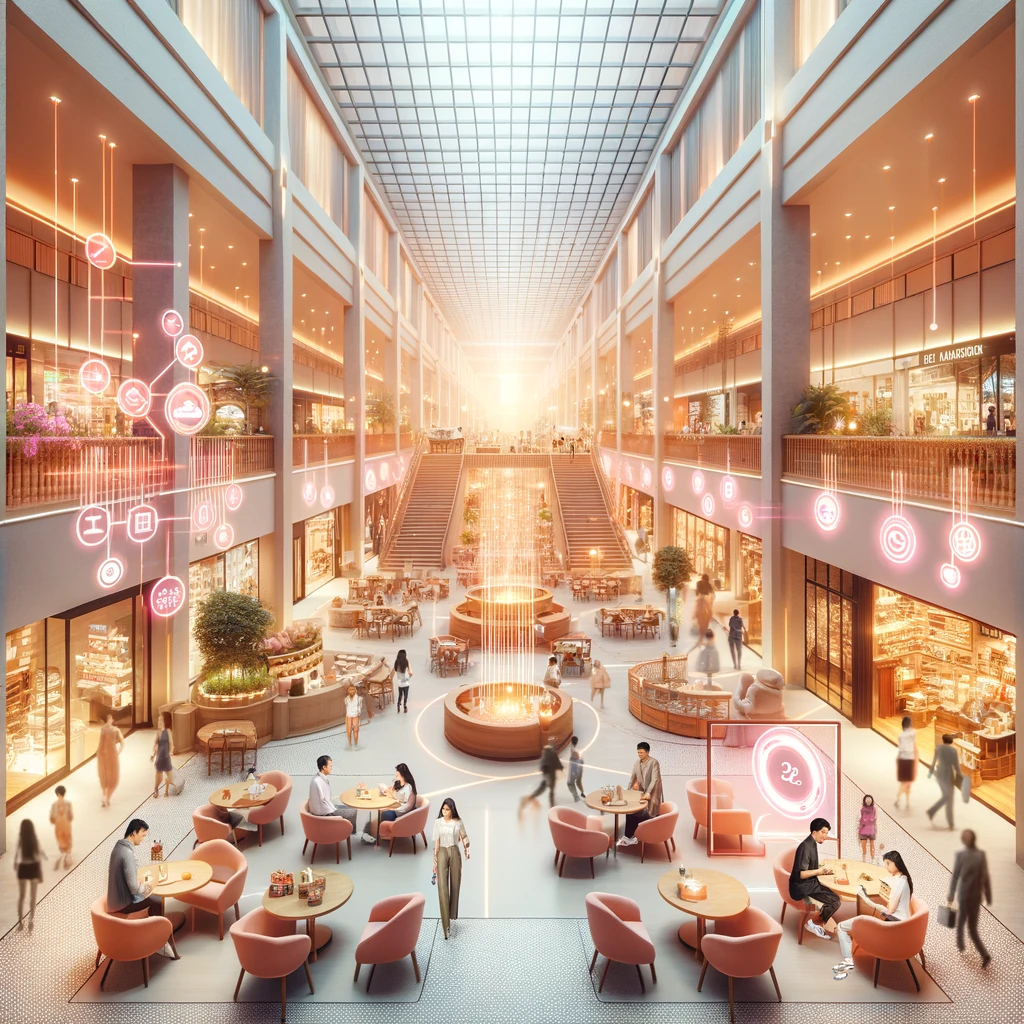The New Era of Mall Marketing

In the rapidly evolving retail landscape, shopping malls are more than just places to shop; they are hubs of social interaction and entertainment. For mall and business center managers, keeping up with technological advancements is crucial to maintaining competitiveness and customer satisfaction. This comprehensive guide explores the various aspects of digital transformation in shopping malls, highlighting how mall marketing, smart building technology, and other innovations can enhance the overall shopping experience.
Mall marketing has evolved significantly with the advent of digital technology. Traditional methods are now being supplemented with digital strategies that leverage data to target and engage consumers more effectively.

Designed by Freepik
1. Digital Signage in Shopping Malls
Digital signage is a powerful tool for engaging customers. These dynamic displays can present a variety of content, from advertisements and promotions to real-time updates and interactive features.
Increased Engagement: Digital signage has been shown to increase brand awareness and boost average purchase amounts.
Real-Time Content Updates: Unlike static signs, digital displays can be updated in real-time, allowing malls to instantly reflect new promotions, events, and announcements. This flexibility ensures that the content remains relevant and timely, which can significantly enhance customer engagement and satisfaction.
Interactive Features: Modern digital signage can include interactive elements such as touch screens, QR codes, and integration with mobile apps. These features encourage customer interaction, providing an engaging and immersive shopping experience. For example, a shopper might use a touch screen to locate a store, view a mall directory, or even browse current sales and promotions.
Targeted Advertising: By using data analytics and customer demographics, digital signage can display targeted advertisements to specific audiences at different times of the day. This targeted approach can increase the effectiveness of marketing campaigns and drive higher conversion rates.
2. Innovative Mall Promotions
Utilizing AR and VR for promotional campaigns has increased shopper engagement rates. These technologies offer immersive experiences that traditional methods cannot match.
Augmented Reality (AR) Promotions: AR allows shoppers to interact with digital elements overlaid on the real world through their smartphones or AR glasses. For instance, a mall might use AR to create virtual treasure hunts where shoppers can find and collect digital discounts or special offers scattered throughout the mall.
Virtual Reality (VR) Experiences: VR can create entirely new shopping environments or enhance existing ones. For example, a mall might offer a VR tour of a new store or a virtual preview of upcoming sales. These experiences can attract tech-savvy customers and create memorable marketing campaigns.
3. Features of Shopping Malls
Modern malls incorporate features like smart directories and interactive kiosks, enhancing the shopping experience and increasing customer dwell time.
Smart Directories: These digital directories provide interactive maps and store information. They can guide shoppers to their desired locations, offer store details, and even provide information on current promotions.
Interactive Kiosks: Placed strategically throughout the mall, these kiosks can offer a range of services from wayfinding to customer service inquiries. They can also collect data on customer interactions to help mall managers understand foot traffic patterns and popular destinations.
4. Enhancing Navigation and Accessibility
Mall wayfinding systems are essential for enhancing shopper navigation within large complexes. Here’s how technology is improving this aspect:
Smart Mall Navigation
Advanced GPS and indoor mapping technologies can reduce the time shoppers spend looking for stores, significantly improving the overall shopping experience.
Indoor Positioning Systems (IPS): Using Bluetooth beacons, Wi-Fi signals, and other technologies, IPS provides accurate indoor location tracking. Shoppers can use their smartphones to receive real-time directions to stores, restrooms, and other facilities within the mall.
Augmented Wayfinding: AR can enhance wayfinding by overlaying digital directions onto the real world, guiding shoppers with visual cues displayed on their devices.
Shopping Mall Wayfinding
Integrated apps that offer personalized directions and store information based on shopper preferences are becoming popular, reflecting a shift towards customized shopping experiences.
Personalized Directions: Apps can customize directions based on the shopper’s preferences, such as avoiding crowded areas or highlighting favorite stores.
Store Information and Reviews: These apps can provide detailed information about stores, including customer reviews, current promotions, and product availability.
5. Building the Digital Infrastructure
Shopping mall website design plays a pivotal role in how malls interact with their customers online:
Shopping Mall Website
A well-designed website acts as the digital front door of a mall, where a significant percentage of shoppers check before visiting in person. An effective site can increase foot traffic and sales by integrating e-commerce functionalities.
User-Friendly Interface: A website that is easy to navigate encourages more extended visits and higher engagement. Key elements include clear navigation menus, fast load times, and mobile optimization.
E-Commerce Integration: Allowing shoppers to browse and purchase items online can capture a significant share of the market. Features such as online catalogs, shopping carts, and secure payment options are essential.
Online Shopping Mall
With e-commerce sales projected to reach new heights, malls are creating seamless online shopping experiences to capture this growing market.
Virtual Storefronts: Individual stores within the mall can have their virtual storefronts on the mall’s website, offering an integrated shopping experience.
Curbside Pickup and Delivery: Offering options for curbside pickup or home delivery can cater to a broader audience, including those who prefer online shopping for convenience.
6. Smart Technologies Transforming Malls
IoT Shopping Mall
IoT in shopping malls is no longer a futuristic concept but a current reality that offers tangible benefits:
IoT technology helps manage facilities efficiently, from energy management to security systems, potentially reducing operational costs.
Energy Management: IoT devices can monitor and control lighting, heating, and cooling systems to optimize energy use, reducing costs and environmental impact.
Security Enhancements: Smart cameras and sensors can improve security by providing real-time surveillance and alerts, helping to prevent theft and ensure shopper safety.
Smart Commercial Property
Incorporating IoT devices for automated lighting, climate control, and security is proving essential for modern malls, enhancing energy efficiency and providing a safer environment.
Automated Systems: Smart systems can adjust lighting and climate control based on occupancy and usage patterns, ensuring comfort while minimizing energy waste.
Safety Protocols: IoT devices can monitor air quality, detect fire hazards, and manage emergency responses more effectively.
7. Enhancing Customer Service and Engagement
In the competitive retail market, mall customer service can be a significant differentiator:
Mall Customer Service
High-quality customer service, facilitated by technology such as AI chatbots and automated information desks, can increase customer satisfaction ratings.
AI Chatbots: These can provide instant answers to common questions, assist with navigation, and even handle transactions, improving the customer experience.
Automated Information Desks: Touchscreen kiosks can offer information on store locations, promotions, and events, enhancing convenience for shoppers.
8. Mall Promotion Activities
Targeted promotions via mobile apps can increase customer return rates, as personalized marketing resonates more effectively with shoppers.
Push Notifications: Mobile apps can send personalized promotions and reminders based on shopper behavior and preferences.
Loyalty Programs: Integrated loyalty programs can reward frequent shoppers, encouraging repeat visits and increased spending.
9. AI in Retail
Predictive analytics and machine learning can optimize inventory management and personalize marketing efforts, potentially increasing sales.
Inventory Management: AI can predict demand patterns and optimize stock levels, reducing wastage and ensuring popular items are always available.
Personalized Marketing: Machine learning algorithms can analyze shopper data to create highly targeted marketing campaigns, improving conversion rates.
The digital transformation journey for malls is not just about adopting new technologies but about rethinking how these spaces operate and engage with consumers. As we move forward, the malls that will thrive are those that view technology not as a tool, but as an integral part of their strategy to enhance every aspect of the shopping experience—from mall marketing to customer service. By embracing these innovations, mall managers can ensure their venues remain competitive and relevant in the digital age.
Do you know that the integration of personalization mall coupons into a mall’s marketing strategy can significantly enhance customer engagement, drive sales, and foster long-term loyalty?















